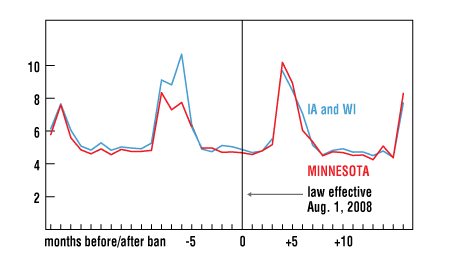I was hoping someone would point out the obvious in the much-talked-about study released yesterday that purported to show that banning texting while driving increases the danger of driving. But, so far, no luck.
Cover me. I’m going in.
TechDirt jumps in with the latest theory:
My concern has always been that I don’t believe the laws work. And, now, it appears that we have some more evidence to support that. A new study has shown that state laws banning driving while texting have not reduced accidents, and in some cases may have even resulted in more accidents. How could it have increased accidents? Because people who want to text anyway — especially unskilled young drivers — begin holding their phones lower to avoid detection, making it that much more difficult to control the car and be aware of their surroundings.
It’s true that maybe the laws don’t work. It’s true that people may be holding their cellphones lower and that’s why there are more accidents. But shouldn’t news stories consist of more? Shouldn’t someone ask, “what DO you know?” That’s what any scientific endeavor should reveal. What someone thinks? Not so valuable.
Here’s the Cars.com description of the study’s methodology:
The HLDI study looked at the crash rates before and after text-ban laws took effect in four states — California, Minnesota, Washington and Louisiana – and compared it to surrounding states that have no such laws. After adjusting for possible changes in collision claim rates unrelated to the bans, the study found that the bans did nothing to reduce crashes. And in three of the four states, crash rates increased after the ban.
There was no analysis of any data of the cause of the crashes; only the crash rates were used. So a person getting drunk and driving down the wrong side of a highway, is included in a statistic that is used to show that the cause of the accident was holding a cellphone lower.
Minnesota was was one of the four states included in the survey. Its accident rate went up 9 percent since the ban was enacted in August 2008 — the biggest jump of any state, according to the study.
It compared Minnesota’s crash data with two neighboring states without texting bans — Iowa and Wisconsin. But look at the chart. Their crash rates went up too.

And check where the spike in numbers occurs: five months after the ban was enacted. In Minnesota, that’s January. If there are bunch of crashes in Minnesota in January, there’s usually another reason besides the prevalence of people holding their cellphones between their knees (It’s also worth noting that the low points of the red line after the ban was enacted is slightly lower than the low points of the red line before the ban was enacted).
And that’s the point the president of the Highway Loss Data Institute, which did the study, misses when he jumps to his conclusion.
“But this doesn’t explain why crashes increased after texting bans,” Adrian Lund points out. “If drivers were disregarding the bans, then the crash patterns should have remained steady. So clearly drivers did respond to the bans somehow, and what they might have been doing was moving their phones down and out of sight when they texted, in recognition that what they were doing was illegal. This could exacerbate the risk of texting by taking drivers’ eyes further from the road and for a longer time.”
There’s no such thing in Minnesota as consistent conditions for driving as there may be in other non-winter states.
But there are other facts to consider, too, that should’ve led the news media to provide more contextual reporting on the story. In Minnesota, for example, the number of highway deaths dropped by 8 percent in 2009. And, according to the Department of Public Safety, the number of crashes in the state actually went down in 2009, not up. Does that have anything to do with a texting ban?
A little more skepticism by the media was warranted on this story. Any study with the word “may” sprinkled throughout requires it.
